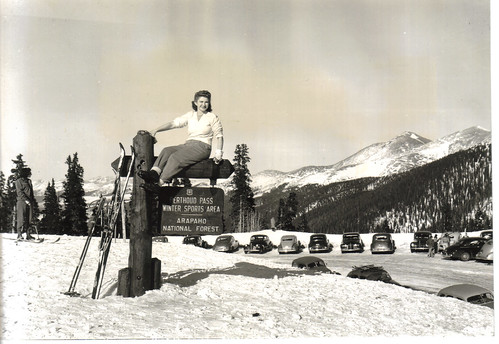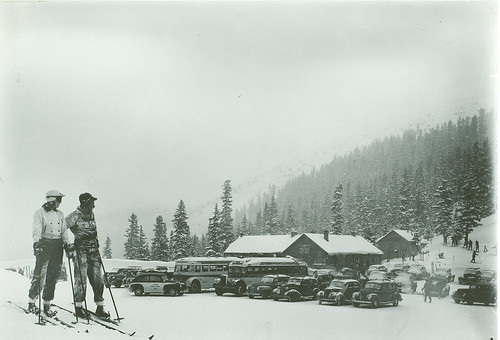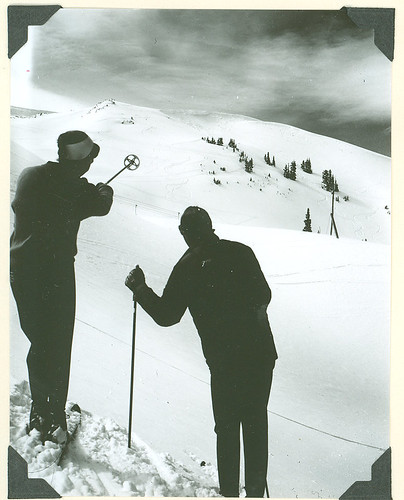
A woman poses atop a U.S. Forest Service sign after 5 feet of snow accumulated at Berthoud Pass Winter Sports Area on the Arapaho-Roosevelt National Forests. (U.S. Forest Service/Jay Higgins)
For the third time, the 2015 FIS Alpine World Ski Championships have returned to the White River National Forest in Colorado, placing special emphasis on the importance of ski area development on national forests throughout America’s history.
Each year millions of visitors ski and snowboard down the snowy slopes of the ski resorts spread across the White River National Forest, and at ski resorts on forests across the nation – 122 resorts that together boast more than 180,000 skiable acres. The Forest Service averages 23 million visits annually to ski areas, contributing $3 billion to local economies annually and creating approximately 65,000 full-time, part-time and seasonal jobs.
Downhill skiing is the second-most popular activity on national forests behind walking and hiking. Skiing has evolved into a booming recreation industry over the past century, and some of the success can be credited with the partnership between the U.S. Forest Service and the privately owned ski resorts, a model that has evolved overtime as something uniquely American.

A historical look back at an early U.S. Forest Service shelter house and parking area at Loveland Winter Sports Area on the Arapaho-Roosevelt National Forests. (U.S. Forest Service/Jay Higgins)
National forests are home to some of this country’s most iconic resorts. Vail and Aspen on the White River in Colorado; Telluride, also in Colorado on the Grand Mesa Uncompahgre and Gunnison National Forests; Snowbird on the Uinta-Wahsatch-Cache National Forest in Utah; and Mammoth on the Inyo National Forest in California. But ski areas on public lands also include smaller yet popular venues like Bogus Basin Mountain Recreation Area. The ski area on the Boise National Forest is a non-profit created by the Boise, Idaho, community in 1942. And skiing on national forests is not limited to the western portion of the United States. White Mountain National Forest in New Hampshire hosts about 1 million skiers every year on eight Nordic and alpine ski areas.
Recreating on national forests is a hallmark of the Forest Service, which is celebrating its 110th anniversary this year. The evolution of skiing has been startling, from small lodges and rope tows to expansive resorts that can now offer year-round activities.
In the 1920s, downhill skiing on national forests grew in popularity as large numbers of Scandinavian immigrants shared their love of winter sports. To accommodate the higher demand, the Forest Service used the Civilian Conservation Corps in the 1930s to help build winter sports areas, including ski trails, sled runs, small ski lodges and warming shelters.

Skiers enjoy the Winter Ski Carnival at Hot Sulphur Springs on the Arapaho-Roosevelt National Forests. Ski and winter sports have been part of the U.S. Forest Service recreation offerings for decades.(U.S. Forest Service/E.A. Snow)
By 1959, the surge on public lands continued, and the Forest Service answered the demand by expanding ski lodges, sled runs, snow-mobile tracks, cross-country skiing, and snowshoe trails. This rapid growth was made possible by partnering with ski clubs and ski resorts, which allowed the Forest Service to supervise the operation, protecting visitor interest and safety, as well as proper land management on the surrounding national forests. Ski areas vary in size and design, but the model of the agency-resort collaboration has persisted through time – with local interest, community support, favorable terrain, proper facilities and snow, ski areas have been able to thrive and draw millions of visitors each year to the national forests.
On Feb. 2, 600 of the world’s best athletes will have a chance to be the fastest out of the starting gates for the 2015 International Ski Federation Alpine World Ski Championships. Athletes will surpass speeds of 75 miles per hour using the forest as their race course and soaring down the mountain in hopes of earning the top spot on the podium. The race takes place on the White River National Forest, where there are 12 ski resorts permitted with 22,975 skiable acres – an area slightly larger than the island of Manhattan.
With more than 100 ski areas operating on your national forests you have lots of options to choose from – find a place to play near you.

Skiers evaluate the snow conditions and terrain at the Arapahoe Basin Ski area on the Arapaho-Roosevelt National Forests. (U.S. Forest Service/Charles E. Grover)
Tags: alpine championships, Arapaho and Roosevelt National Forest, Boise National Forest, California, Civilian Conservation Corps, Colorado, cross-country skiing, Forestry, FS, Grand Mesa Uncompahgre and Gunnison National Forests, Idaho, Inyo National Forest, mountains, New Hampshire, recreation, skiing, Uinta-Wasatch-Cache National Forest, Utah, White Mountain National Forest, White River National Forest, winter sports
No comments:
Post a Comment